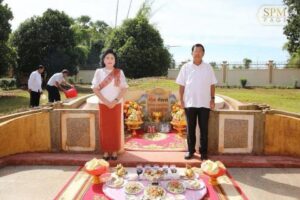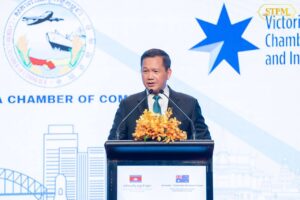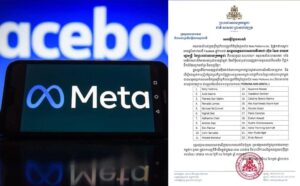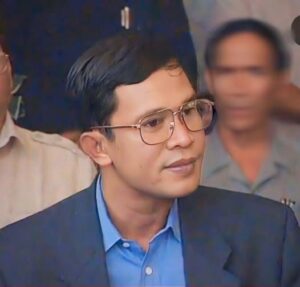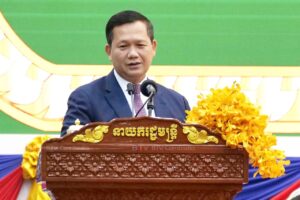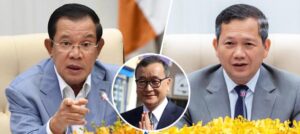Selected Comments Samdech Techo Hun Sen, on Cambodia-Laos-Vietnam Triangle Development Cooperation Framework (CLV-DTA or Development Triangle Area)
(1) Suggesting a crackdown on those faking social media accounts and those distort the fact on development triangle area to face the law
[…] I am calling on the person who posted a fake picture of me, in a Facebook account, publicizing that I have sprained my shoulder and needed treatment in Singapore (which I posted in my account in 2019) […] and other Facebook users to stop immediately if they do not wish to have legal issue […] I have only one account (on social media such as) Facebook, TikTok, Instagram, X, YouTube. I do not have two or three. I suggest that a search must be carried out to crack down on this […]
Lately, there are people who have slandered the situation and even accused the Cambodian leader, especially myself as well as Prime Minister Hun Manet, of being traitors in connection with, according to what they said, “the cutting of four provinces to Vietnam.” For those in a country that distorts the fact, they will have to face with the law. Those residing abroad who incite this must also know that their incitements and manipulation will have caused their co-conspirators inside to go to jail […]
(2) The former Prime Minister’s interpretation of the establishment of the Cambodia-Laos-Vietnam development triangle will be more educational
The question is, why did the former Prime Minister come forward to explain on this issue (relating to the establishment of the Cambodia-Laos-Vietnam development triangle)? I think that my interpretation may be deeper than what the next generation would, because this work started from when I was in power and attended 11 summits from 1999. Now, we preparing for the 12th meeting that Cambodia will host after it was held in Laos. Who was the mastermind behind the development triangle of Cambodia, Laos and Vietnam, popularly known as CLV? […]
Last night I watched on YouTube (and James Sok mentioned that the development triangle was) a Vietnamese initiative proposed at a meeting in Laos in 1995. If Mr. James Sok dares to swear, even if on a dog life, he would consider a hero […] the creation of this development triangle is my initiative. During my visit to Laos, I asked the Lao side to support the idea, and His Excellency Sisavath Keobounphanh, the then Prime Minister did […] I sought the Vietnamese Prime Minister’s support to the initiative. The Prime Minister of Vietnam at that time was HE Phan Văn Khải. He too passed away. The only person who participated in the establishment of the Cambodia-Laos-Vietnam-Vietnam Triangle Development Zone mechanism left is me […]
(3) The northeastern region of Cambodia, a part of Vietnam and a part of Laos, where the three borders meet are poor
One may ask why it is necessary to create this triangle development zone. What to start with? In the northeastern region (of Cambodia), a part of Vietnam and a part of Laos, where the three borders meet are the poorest and most difficult access areas. If we talk separately about Cambodia, in the 1980s until the millennium or from the 20th century to the 21st century, especially in Ratanakkiri and Mondulkiri provinces, we traveled to and from through Vietnam […] at that time along the 5NR 78 there were on the one hand (insecurity) by the Khmer Rouge and on the other hand the bad condition of roads. We had to rely on Vietnam’s route […] some products are also exported through Vietnam […]
(4) Four factors for the three countries to launch the development triangle zone cooperation
[…] The consideration (on organizing the development triangle of Cambodia, Laos, Vietnam) stemmed from four main factors […] first, the economic connectivity required for infrastructure, roads, electricity, trade in goods, tourism, production and export by sea through Vietnam […]; secondly, consideration on security and national defense issues […]; third, provision of cooperation in the fields of education, training of human resources and health sector among the three countries […]; and fourth, management cooperation of disasters along the border, especially floods and wildfire […]
(4) The second meeting in 2002, Cambodia, Laos and Vietnam initiated the idea of including provinces in development projects
The Development Triangle Area (DTA) had its first meeting held in Vientiane, Laos, in 1999. At that time, (Prime Minister) HE Sisavath Keobounphanh chaired the meeting. I represented Cambodia, and the late Prime Minister His Excellency Phan Văn Khải represented Vietnam. The second meeting was held in 2002 in Ho Chi Minh City of the Socialist Republic of Vietnam, for which I represented the Kingdom of Cambodia, there was a new Prime Minister of Lao (PDR) and Prime Minister Phan Van Khai represented Vietnam […] the three parties agreed to include some provinces as a starting point.
The Cambodian side requested for Ratanakkiri and Stung Treng provinces in 2002 to be placed in the development project. Laos has requested to include Attapeu and Sekong provinces, and Vietnam requested for the inclusion of Kon Tum, Gia Lai and Dắk Lắk provinces – a total of seven provinces altogether. At the 2004 meeting in Siem Reap of Cambodia, for which I chaired the meeting, the Prime Minister of Vietnam Phan Văn Khải and the Prime Minister of Laos Bounnhang VORACHITH (?) came. Cambodia decided to include Mondulkiri province, Laos included Salavan province and Vietnam requested the inclusion of Dak Nông. By 2010, we agreed to include more provinces, Kratie from Cambodia, Champasak from Laos, and Binh Phước from Vietnam […]
(6) There is no agreement to integrate the territories of the three countries other than socio-economic, security and defense
This is what we agreed on. The fact that the three countries have placed these provinces in the DTA is not for the creation of a separate country or for these provinces to be a federal province as alleged today. I would share with you that we have already arrested three people (who have made false accusation) from Siem Reap. They may teach about the Paris Peace Agreement in TikTok or other social media but when they (use their speech to) provoke instability, we cannot let them go on. Let us go to court. They may find their backup documents. On our side, we will put together documents […]
In fact, regarding the establishment of the DTA, Cambodia is not the only beneficiary country. Vietnam benefits from such cooperation too. Vietnam is a country with agricultural processing techniques, while Cambodia and Laos have raw materials, such as cashew nuts, that can be sent for processing […]
Laos benefits from it too. The benefit we have from Laos is the supply of electricity to Cambodia, which has grown the Lao-Cambodian trade volume. Cambodia imports in large quantities from Laos. Cambodia exports less to Laos but buys more electricity from Laos from year to year. According to the agreement, if there are no obstacles, Laos will have to sell nearly 4,000 megawatts of electricity to Cambodia […]
Without access to sea, Laos has had difficulty in producing local salt for consumption. DTA allows Cambodia to export salt to the southern part of Laos. Laos also enjoys the benefits that Cambodia has provided since the 1980s with access to the sea via National Road 7, as it used to be, to Kratie, and then on the Mekong River […]
(7) In 26 years of development, China has provided connectivity assistance
In more than 20 years, maybe 26 years, from the beginning until now, Cambodia has developed at a rapid pace. All that has been possible because we went to China for help. In the case of Mondulkiri, it is connected by National Road 76 from Snuol district to the provincial town, and then from the provincial town of Sen Monorom to the Vietnamese border at the Dak Dam and Dak Huot point, which facilitates transportation for the people in Mondulkiri province. The NR 78 from Oyadao to Banlung – the Ratanakkiri provincial town was built with the support of the Socialist Republic of Vietnam, to the road from Banlung to Stung Treng, built with financial support from our China friends. The connection from Ratanakkiri to Mondulkiri on National Road 76 was built with financial support from the People’s Republic of China […]
(8) There should be no reduced sentence or pardon but imprisonment until the end of their term
Is there any point that is related to the exchange of sovereignty? If there is an exchange of sovereignty, why would it be necessary for the three countries to define borders among them? Such accusation (above) is an unpardonable insult. I would ask the court, if there is going to be a trial, to consider maximum punishment level. The Ministry of Justice and prisons authority should not put these people on the list of those who will have reduced sentence or pardon. They should be imprisoned until the end of their term […]
(9) Cambodia has neither Degar or Montagnard nor Kok Sar (White Egret)
Is this defamation and painting a betrayal? I would like to inform you that this agreement is different from the agreement that the traitor signed with Kok Sar (white egret – the leader of the Degar or Montagnard). Some have demanded for proof (that that politician had signed allowing the Degar to use our territories). I understand that there is no need to find other documents to confirm it. They may just look at the picture of their signing ceremony. It is interpreted as respecting the rights of indigenous peoples. However, Cambodia has never had Degar or Montagnard and its leader – Kok Sar. Cambodia has ethnic groups in Ratanakkiri, Mondulkiri, Kratie, Stung Treng and Kreung […]
It is however not necessary for Cambodia to sign an agreement with them in these provinces […] as for the document signed by the traitor with Kok Sar, you may observe that there was a separate flag for Kok Sar […] that s/he has not yet come to power, s/he dare to authorize foreigners to conduct activities on the territory Cambodia in four provinces – Ratanakkiri, Mondulkiri, Stung Treng and Kratie. Look at the backdrop of the signing ceremony, while s/he her/himself has a flag (and Kok Sar has a flag,) there was also the American flag in the center. What does that mean? […]
(10) In 2005, Japan provided US$ 20 million for small projects in DTA
The first summit was held on October 22, 1999 in Vientiane, Laos. The second meeting was held in Ho Chi Minh City, Vietnam on January 26, 2002. The third meeting held in Siem Reap, Cambodia, 2004. Let me clarify when the partnership with Japan took place […] it was during the government of Prime Minister (Junichiro) Koizumi, and we had the CLV-Japan summit along with the ASEAN Summit in Kuala Lumpur in 2005. Japan provided US$ 20 million for small projects in development triangle area […]
We have transformed area with least development into a well-developed one, and the living conditions of the people have improved significantly. For example, the per capita income per year from the beginning was only US$ 294. As of now, it has gone up to 1,300 US dollars. This has indicated an increase in Cambodia’s capacity, with internal elements as key players, together with good cooperation with (neighbors) in the triangle area, and a combination of incoming assistance from China and Japan to the area. We need to step up the pace of building the necessary infrastructure for each country […]
(11) Allow no insults to the country, HM the King, and will of the people
Overall, we do not accept any (negative) accusations of what we have done for the national interest. (Some say) it will become the Federation of Indochina, or it will be the Indochina Triangle. Some call it the (Golden Triangle) […] I would call on Prime Minister Hun Manet to urge the relevant institutions, especially the Ministry of Commerce, to release all the statements (regarding DTA) […] I do respect human rights, but for wrongdoing, even in your own country, you would not forgive. We cannot allow someone to create incitement and turmoil. (Cambodia) must be serious and thorough […]
Some have even posted demonstrations. What it means is for the Court of Appeal to increase the aggravating sentence on their agents […] I warn everyone not to insult the country, not to insult HM the King, and not to insult the will of the people. Other countries should also do the same and give value to the millions of voted […] why Cambodia cannot enforce its own laws when other countries can? I hope friends will understand. Cambodia needs peace and political stability to ensure long-term development. Cambodia will not tolerate anyone who opposes and creates unrest, chaos, and disrupts development or even leads to war […]
(12) On the NR 78.5 to the dragon-tail shape land, new economic pole and the Cambodia-Laos bridge at Tonle Lpov
I hope that the Royal Government will continue to work hard to build National Road No. 78.5 from Ratanakkiri’s […] Banlung to the dragon tail (shape land in the DTA), 166 kilometers long, 9 meters wide […] and I wanted (for the Royal Government to consider) transforming the provinces of Kratie, Stung Treng, Ratanakkiri, Mondulkiri, in the future, to be another economic pole (in the northeast), where there will be development of agroindustry and mineral resources […] which we can process cashew nut and rubber for export […] and mineral as we have been working on gold by the company from Australia, and we also have Bauxite […] In the future, since the province of Preah Vihear is bordering with Laos, maybe the Cambodian government would consider include it in the development triangle too. Hence, we have to build a bridge over the Tonle Lpov (Pumpkin River) connecting the Preah Vihear province on the Cambodian side to Laos. Cambodia and Laos may seek to get a loan from China together to build the bridge. If there is going to be such cooperation, we will need to decide at which point exactly that the bridge should be […] as China helps with the bridge financing, Laos and Cambodia would build connecting roads on their owns on their sides. Is this not a benefit? […]

 ទំព័រដើម
ទំព័រដើម ព័ត៌មាន
ព័ត៌មាន សម្រង់ប្រសាសន៍
សម្រង់ប្រសាសន៍ កិច្ចសម្ភាសន៍
កិច្ចសម្ភាសន៍ ព័ត៌មានទីផ្សារការងារ
ព័ត៌មានទីផ្សារការងារ ព័ត៌មានសេដ្ឋកិច្ច
ព័ត៌មានសេដ្ឋកិច្ច បច្ចេកវិទ្យា
បច្ចេកវិទ្យា អាស៊ាន | ASEAN
អាស៊ាន | ASEAN បទយកការណ៍
បទយកការណ៍ ប្រភពផ្សេងៗ
ប្រភពផ្សេងៗ ឯកសារ
ឯកសារ វប្បធម៌-ប្រវត្តិសាស្រ្ដ-សាសនា
វប្បធម៌-ប្រវត្តិសាស្រ្ដ-សាសនា ការកំសាន្ត | កីឡា | សុខភាព
ការកំសាន្ត | កីឡា | សុខភាព បច្ចេកវិទ្យា | ប្លែកៗ
បច្ចេកវិទ្យា | ប្លែកៗ កសិកម្ម
កសិកម្ម ទស្សនៈ-នយោបាយ
ទស្សនៈ-នយោបាយ វិចិត្រសាល
វិចិត្រសាល Live Streams
Live Streams ទំព័ររូបថត
ទំព័ររូបថត ទំព័រវីដេអូ
ទំព័រវីដេអូ Facebook.
Facebook. CoolApp
CoolApp English
English